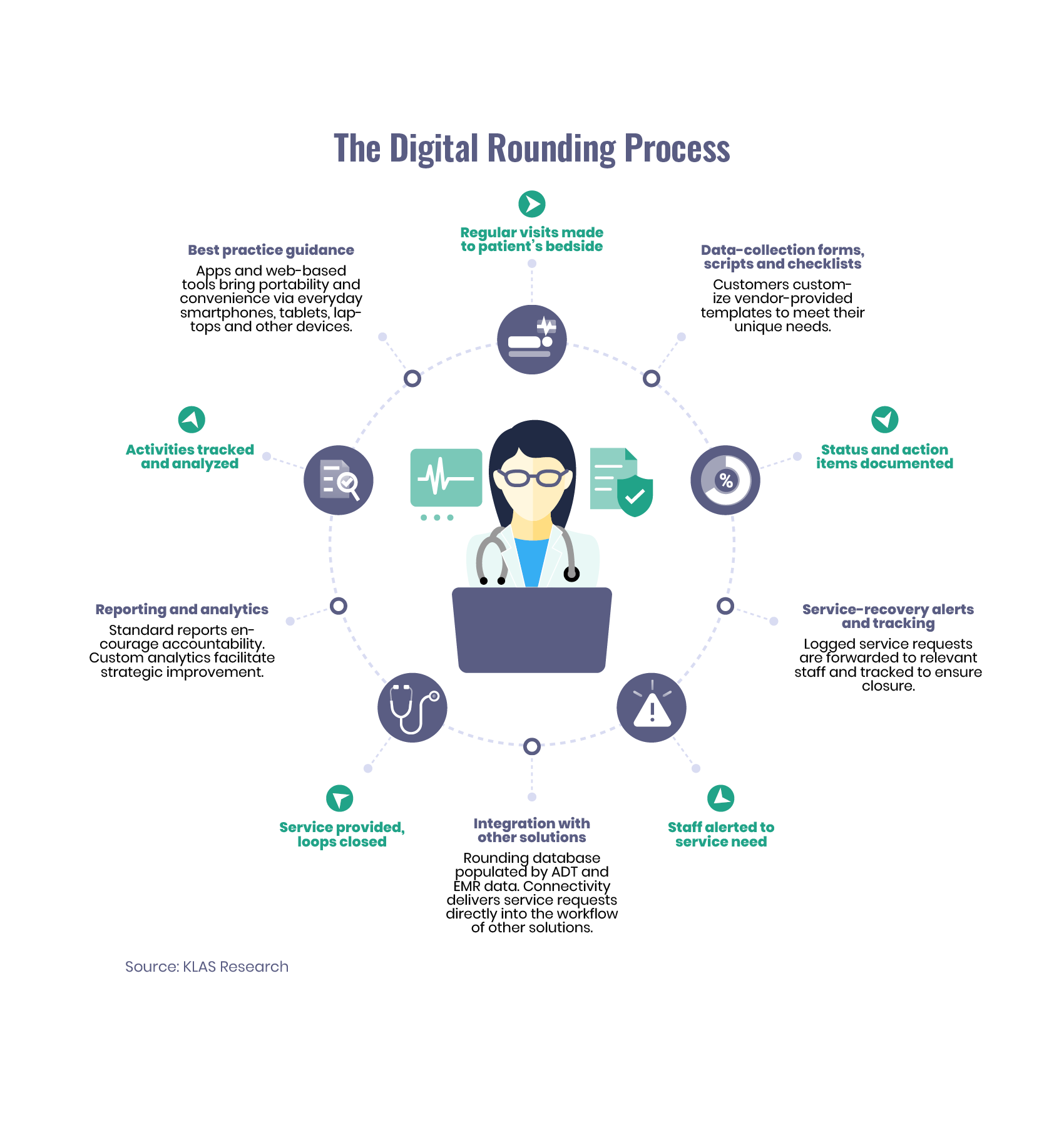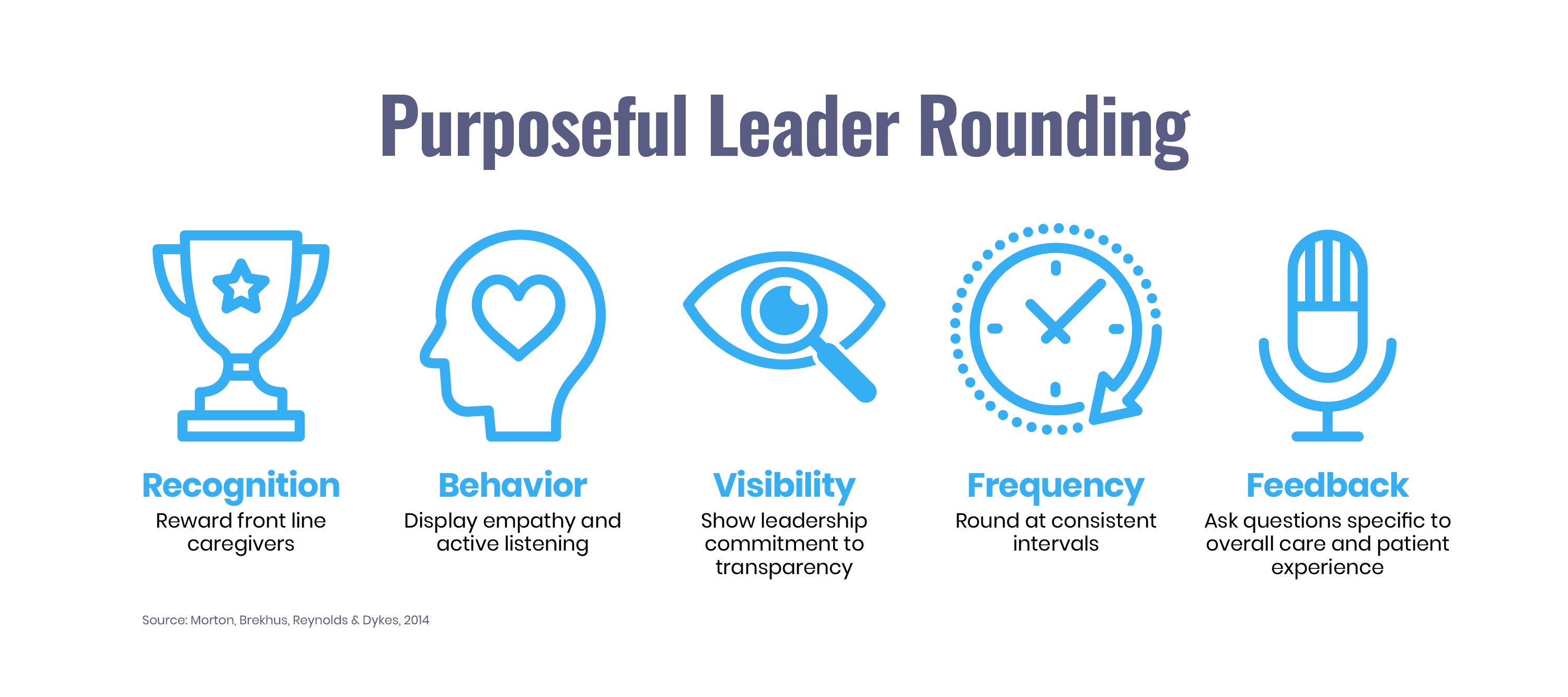6 min read
Rounding in Hospitals: How This One Tool Can Improve Outcomes
Performance Health Partners
January 24, 2025
Rounding in hospitals encompasses a range of practices that are instrumental in enhancing patient and employee safety. This article explores the tangible benefits of various types of rounding, shedding light on how healthcare organizations utilize rounding to detect and address potential risks. By conducting comprehensive assessments, these rounding practices allow healthcare professionals to proactively mitigate potential issues before they escalate into larger threats to employee and patient safety. Read on to learn more about the significance of rounding in hospitals and for real-life examples that illustrate rounding’s vital role in ensuring the well-being of patients and healthcare workers alike.
Types of Rounding in Hospitals
The path to improvement begins by acknowledging our blind spots.
This is the logic that guides us to schedule regular check-ups with our primary healthcare provider, to inspect the air pressure in our tires before taking off on a long road trip, or to routinely test the batteries in our smoke detectors.
Patient Rounding for Improved Safety and Outcomes
This concept holds paramount importance in healthcare. Regular patient rounding illustrates this approach, rooted in the understanding that undiagnosed or latent issues could escalate into severe situations if left unchecked. Hospital safety rounds – or bedside rounds – therefore, serve as an essential component of a broader strategy aiming to uphold the highest standards of patient care.
When healthcare teams make the effort to observe whether systems and processes worked correctly through effective patient rounding, they are able to identify the warning signs of potential accidents and events such as:
- Delayed Diagnosis: By engaging regularly and directly with patients, teams can detect symptoms or changes in a patient's condition that may otherwise go unnoticed, potentially leading to a delayed diagnosis.
- Medication Errors: Patient rounding aids in the timely identification of discrepancies in medication administration, which could include: wrong dosage, incorrect medication, or unfavorable drug interactions.
- Patient Falls: Regular observation and interaction of the patient's physical capabilities can alert staff to changes in mobility, helping to prevent patient falls, an increasingly common safety event in the healthcare environment.
- Infection Outbreaks: Patient rounding enables healthcare teams to monitor infection control practices and promptly identify early signs of hospital-acquired infections, aiding in preventing potential outbreaks.
- Patient Dissatisfaction: Regular patient rounding allows healthcare teams to gauge patient experience and satisfaction in real-time. They can promptly address concerns, improving overall patient experience and preventing potential grievances.
Types of proactive patient rounds include:
- Hourly Rounding: Often utilized in hospital settings, hourly rounding is the most common type of patient rounding. As the name implies, healthcare workers visit patients at regular intervals, usually every one or two hours. The goal is to address key areas of concern: pain, personal needs (such as using the restroom), position (making the patient comfortable), and proximity of personal items (making sure everything the patient needs is within reach). Digital hourly rounding tools help to facilitate and streamline this process.
- Leadership Rounding: In this form of rounding, members of the hospital's leadership or management team make rounds to interact with patients and/or patients’ family members or caregivers. This helps leaders to directly understand patient experiences, identify potential areas for improvement, and make decisions. Leadership rounding often focuses on improving patient satisfaction and quality of care.
- Multidisciplinary Rounding: This approach involves a team of healthcare professionals from various disciplines including physicians, nurses, pharmacists, social workers, etc. Each team member brings their unique perspective and expertise to the patient's care plan. In this way, multidisciplinary rounding helps ensure all aspects of a patient's care are considered and coordinated, from medical treatment to discharge planning.
Employee Rounding for Improved Engagement and Satisfaction
Employee rounding is a proactive employee engagement approach in which healthcare executives or department leaders personally interact with staff to gather valuable insights, not only brings to light what is and isn’t working in an organization.
Examples of employee rounding include:
- Daily Department Rounding: This type of rounding involves organization leaders or managers visiting each department on a daily basis to discuss current issues, progress, and any potential areas of concern. It gives leaders an up-close look at departmental operations, enhances team communication, and allows for real-time problem-solving.
- Peer-to-Peer Rounding: In this approach, colleagues within the same department or across departments assess each other's workspaces, systems, or procedures. This process can foster an environment of shared learning, collaboration, and can result in the cross-pollination of best practices.
- Recognition Rounding: This process is focused on acknowledging and appreciating the hard work, wins, and dedication of staff members. During these rounds, hospital leaders or managers actively look for instances of exemplary work or exceptional patient care to celebrate – such as the interception of a near miss. This can significantly boost staff morale, reinforce positive behaviors, and foster a more positive work culture. Recognition rounding also provides an opportunity for leadership to directly connect with employees, offering a platform for open dialogue and feedback.
Rounders might ask the following questions during employee rounds:
- What’s working well?
- What resources are most effective in supporting your job performance? Which additional resources could help you do your job better?
- Do you have suggestions for enhancing collaboration within the department?
- Is there anything you’d like to share about your work-life balance?
- How would you describe your overall job satisfaction?
- Who on your team deserves recognition for a job well done?
Frontline workers are the eyes and ears of every healthcare organization. By personally discussing the day-to-day issues faced by these employees, leadership gains a deeper understanding of existing concerns, paving the way for effective solutions to be implemented.
Employee rounding in healthcare is also the single most effective tool for making employees feel heard and appreciated, which is becoming increasingly more important in today's dynamic and ever-evolving healthcare space.
Other benefits of employee rounding include:
- Gaining feedback around the work environment
- Addressing and alleviating issues within the care environment
- Building trust
- Promote a culture of safety
Moreover, when leaders of an organization actively demonstrate their willingness to listen and seek feedback from employees – and follow up on corrective actions taken – it creates an environment where employees feel empowered and comfortable expressing their thoughts and concerns.
Environment of Care Rounding for a Safer Care Environment
As healthcare has evolved to focus more on patient-centered care, environment of care (EOC) rounding has become an increasingly useful tool for improving patient and staff engagement in safety promotion. According to the Joint Commission, “protecting patients from harm involves more than safe treatments and procedures. We must also consider where patients receive care and minimize risks associated with the physical environment.”
EOC rounds play a critical role in ensuring the safety of patients and staff and optimizing the overall operations of a healthcare facility. They can uncover issues such as:
- Clinical staff not wearing appropriate shoes
- Missing fire equipment
- Obstructed walking paths
- Unlocked doors leading to areas that should be secured
- Exits not clearly indicated
- Empty soap dispensers at handwashing stations
- Malfunctioning nurse call buttons
- Mold under the sinks
- Staff unaware of how to report a near miss or actual incident and follow-up processes
Every action item on an EOC rounding checklist should be clearly defined and have a specific person assigned to the task to ensure that it is properly completed. An EOC rounding checklist might ask questions such as:
- Does the room need to be rearranged (with the patient’s permission) to clear paths?
- Are all examination tables adjusted into locked position?
- Has the room been arranged so that items are within the patient’s reach (e.g., are walking aids within safe reach)?
- Are there any burned out or flickering light bulbs or call lights that need to be replaced? Have any clean glove boxes been placed on top of used sharps containers?
- Are wet-floor signs used and removed in a timely manner?
Hand Hygiene Audits for Improved Hand Hygiene Compliance
Hand hygiene – a simple yet crucial aspect of healthcare –often falls short of the standards. In fact, the Centers for Disease Control and Prevention research shows that on average, healthcare personnel clean their hands fewer than half of the times they should.
Environmental factors influencing noncompliance with hand hygiene protocol vary between organizations and can include lack of soap at handwashing stations, lack of training around hand hygiene protocol, or lack of sufficient number of sinks.
Hand hygiene rounding is a dedicated approach designed to identify these contributing factors to noncompliance, thereby guiding strategic decisions for improvement. Below are some instances of hand hygiene rounding:
- Direct Observational Rounding: In this process, a team member discreetly observes healthcare personnel during their shifts, noting whether hand hygiene protocols are adhered to before and after patient interactions. This hands-on assessment provides real-time data about compliance levels.
- Training Rounding: This type of rounding in hospitals involves periodically visiting different departments and offering on-the-spot training and reminders about proper hand hygiene. It's an opportunity to correct any improper methods, reinforce the significance of hand hygiene, and answer any related queries.
- Resource Availability Rounding: Here, dedicated staff members regularly check hand hygiene resources, such as ensuring that soap dispensers are filled, hand sanitizer is readily available throughout the facility, and sinks are functional and accessible.
The Transformative Power of Rounding Software
To optimize the effectiveness of rounding in hospitals, organizations can leverage digital tools to streamline the process. Implementing a rounding software optimizes the rounding experience, saving time, and maximizing the impact of feedback for continuous improvement.
Today’s rounding software like Performance Health Partners’ streamline efforts to effectively round on patients and employees, manage risks, and make the delivery of care as efficient and convenient as possible. They achieve this by ensuring standardization through a structured framework for rounding in hospitals, maintaining consistency across different departments and locations.
For instance, the use of real-time data dashboards removes the need for cumbersome manual data compilation and analysis. Rounding software allows organizations to assess performance, input rounding data, and devise immediate action plans with only a quick glance at the screen and a few clicks!
Rounding software also enables teams to conduct assessments quickly and conveniently, as technology facilitates rounding processes by standardizing templates, including checklists. Then, based on the collected data, risks can be immediately identified and classified.
Should a provider identify an issue while rounding, a structured incident management system makes incident reports available via computer, tablet, or smartphone. Once a report is submitted, the system then triggers an automatic workflow to ensure the appropriate contacts are notified in real time. If the issue isn’t resolved within the designated time frame, the software automatically escalates the event.

Rounding software like Performance Health Partners’ not only provide streamlined efficiency and enable faster issue resolution, they also improve patient outcomes. According to a 2018 KLAS Research report, survey respondents noted several key meaningful outcomes achieved with using technology to round on patients. Among the most common were improved patient satisfaction, immediate feedback and recovery, accountability/compliance, and better collaboration among care teams.
Ready to get started?
Implementing rounding and incident reporting software is an integral part of establishing an effective patient safety culture.
With Performance Health Partner’s digital rounding solution, healthcare organizations can take action against the harmful effects of safety incidents, while focusing on improving the quality of the care experience. Connect with our team to learn more.




